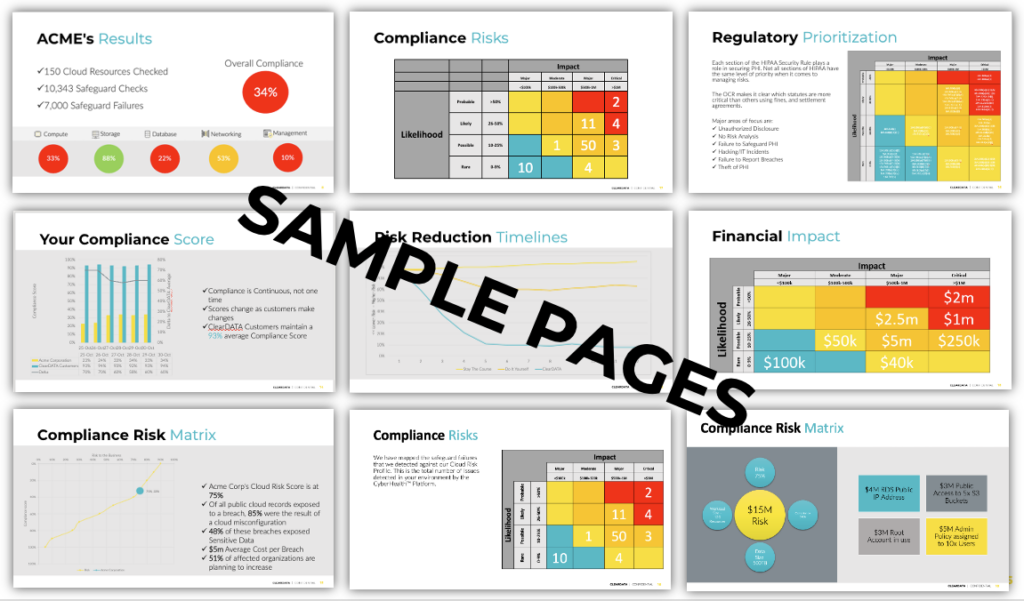It’s no surprise that with the explosion of AI, cyber-attacks on healthcare are growing in both their level of sophistication and frequency. We saw cyber threats in healthcare ranging from ransomware exploits like CL0P, which compromised the private information of over 23 million people, to the Rhysida attack, that forced nearly 200 hospitals and clinics to take their systems offline. Notably, threat actors also turned to AI for nefarious uses with the release of WormGPT and FraudGPT.
Interestingly, most of the healthcare cyber-attacks observed in 2023 stemmed from U.S.-based IP addresses, which marks a notable shift from data over the previous 2-3 years, where Eastern European countries were the main source of attacks.
Our team, like many others, witnessed a record number of identity-based attacks targeting remote access services, including exposed ssh, rdp, and vpn servers. Most of these attacks are unsophisticated password spraying attempts, which can be easily mitigated by implementing certificate-based authentication and MFA authentication whenever possible.

And in the wake of the ransomware attack on Change Healthcare causing record delays in payments, creating issues for patients waiting on much-needed medications and care, some healthcare companies are bleeding in financial losses, many losing up to $100 million per day.
We know the healthcare industry and protection of PHI depends on knowing who these bad actors are, what their attack methods look like, and how to fight back against becoming the industry’s newest victim. So, in collaboration with Medecision and Ordr, we held a webinar led by industry experts to review the report’s findings and uncover the top healthcare cybersecurity threats.
Vice President of Security at Medecision, Chief Healthcare Officer at Ordr, and Vice President of Managed Cybersecurity Services at ClearDATA brought their valuable insights to the table. Read on for their full insights, and watch the on-demand recording of our Healthcare Threats webinar.
Let’s dive into some of these threats and what you can do to combat them.
Healthcare Cybersecurity Threat: Ransomware
Ransomware attacks on hospitals are becoming more frequent, and threat actors are innovating with their negotiation tactics, which means they hit harder and more broadly than ever before. With more ransomware groups specifically targeting PHI and other sensitive healthcare data, we need to stand ready with meaningful countermeasures and risk mitigation strategies.
Healthcare cybersecurity defense measures need to evolve to stop cybercrime in its tracks. Specifically, attack automation is often implemented to help attackers move quickly and hit as many applicable targets as possible. The ransomware as a service market continues to grow, which includes initial access brokers, and sample development lowers the bar to create a campaign.
Additionally, and even more unfortunately, threat actors are utilizing multiple extortion methods to extract payment and publicly humiliate victims. More HCOs will fall victim to healthcare cybersecurity risks by well-known actors targeting “low hanging fruit” common to the industry.
Actionable advice – Know your adversaries! Understanding the threat of ransomware allows you to deploy meaningful countermeasures and effectively manage risk. Working with a knowledgeable cybersecurity team that deeply understands healthcare data breaches and how healthcare data gets targeted and exploited by these ransomware groups is your best defense, though monitoring ransomware attack news and intel on these groups can also help you stay vigilant.
Software Vulnerabilities: Persistent Healthcare Cybersecurity Threats
In 2023, the industry was plagued by a lack of urgency in addressing widespread vulnerabilities in internet software utilized by the industry. Legacy healthcare applications, file sharing utilities, and administrative portals often have flaws that threat actors exploit. To mitigate these threats, it’s crucial to have comprehensive external attack surface monitoring and a robust vulnerability management program.
The industry can expect to see an increasing need for comprehensive external attack surface monitoring (EASM) and visibility into software bill of materials (SBOM). Also, anticipate organizations emphasizing optimizing processes for identifying relevant emerging threats and quickly addressing associated software vulnerabilities.
Actionable Advice: Know your environment! Knowing your attack surface and exactly where PHI is located within your environment is crucial for healthcare data defenders to gain visibility and effectively mitigate or remediate well-known flaws.
Overlooked Threat: Supply Chain Components
Third-party vendors often become an easy target for cybercriminals as compromising them yields high returns. Because of their widespread adoption and interconnected systems, they offer multiple opportunities for a payout. It’s vital for teams to Implement a Cybersecurity Supply Chain Risk Management Program (C-SCRM) that holds third-party vendors to consistent security and strategy standards.
Actionable Advice: Implement a Cybersecurity Supply Chain Risk Management Program (C-SCRM)
There is no need to reinvent the wheel. There are existing frameworks like the NIST Cybersecurity Supply Chain Risk Management (C-SCRM) program, which helps organizations manage the increasing risk of supply chain compromise related to cybersecurity, whether intentional or unintentional.
Emerging Threat: Artificial Intelligence
While AI promises to revolutionize healthcare, it also introduces new risks. As organizations rapidly adopt AI without sufficiently implemented safeguards, the technology may be used for malicious intent. That’s why you need to plan and secure AI technologies before adopting them fully and integrating them with your healthcare cloud.

The industry can expect to see a continued increase in social engineering focused campaign volume. Additionally, open-source tools facilitate more convincing, customized bait, specifically designed to mimic VIPs and executives to fool employees. Healthcare is rapidly innovating, and there’s a race to integrate AI in the name of improving patient care, but it’s crucial to have an adequate plan for addressing complex new vulnerabilities.
Actionable Advice: You must slow down…to go fast!
Rapidly adopting technology without having a well-formed idea of the risk it introduces and how to secure it is a recipe for disaster. Business leaders can’t be enticed by technological sirens.
Moving Forward
Successfully navigating cybersecurity challenges requires a level-headed approach to risk assessment and understanding the broader threat landscape. Expand your vulnerability management programs to include vendor risk and establish a clear business strategy around the secure adoption of AI.
Know how much you can and can’t manage alone in this new era of ransomware groups and other ruthless attackers going after healthcare data. Work with a knowledgeable, healthcare-focused cybersecurity team who will partner with you to fortify your healthcare cloud, prioritize Healthcare information security, and offer actionable steps to mitigate your risk of a security breach.
And when it comes to cloud partners, be judicious – your protection is only as good as theirs. We’ll be hosting a new webinar on April 30 on assessing and mitigating your third-party risk to help walk you through it every step of the way.
Thanks to those who joined the live webinar on healthcare cloud security vulnerabilities, and if you missed it or want a re-watch, watch the on-demand recording.
FAQ:
What are the most common types of cybersecurity threats facing healthcare today?
Healthcare organizations face a myriad of cybersecurity threats, with some of the most common including but not limited to:
- Ransomware Attacks: Malicious software that encrypts a victim’s data, demanding a ransom for the decryption key. Healthcare is particularly targeted due to the critical nature of patient data and the urgency to restore access.
- Phishing Attacks: Deceptive attempts to obtain sensitive information by masquerading as trustworthy entities. These attacks often lead to data breaches and compromised systems.
- Insider Threats: Employees or contractors who misuse their access to sensitive information, either maliciously or accidentally.
- Malware: Various types of malicious software, including viruses, worms, and trojans, that can damage or disrupt systems.
- Distributed Denial of Service (DDoS) Attacks: Overwhelming a network or website with traffic to make it unavailable to users.
- Advanced Persistent Threats (APTs): Prolonged and targeted cyberattacks where an intruder gains access to a network and remains undetected for an extended period.
How can healthcare organizations protect against ransomware attacks?
To protect against ransomware attacks, healthcare organizations should implement a multi-layered approach, including but not limited to:
- Regular Backups: Maintain frequent and secure backups of all critical data, ensuring they are not connected to the main network.
- Employee Training: Educate staff on recognizing phishing attempts and other social engineering tactics.
- Robust Security Measures: Use up-to-date antivirus software, firewalls, and intrusion detection systems.
- Patch Management: Regularly update and patch systems and software to address vulnerabilities.
- Access Controls: Limit access to sensitive data based on roles and enforce the principle of least privilege.
- Incident Response Plan: Develop and test an incident response plan to quickly react to and mitigate the effects of a ransomware attack.
- Multi-Factor Authentication (MFA): Implement MFA to add an extra layer of security for accessing systems and data
What role does HIPAA compliance play in mitigating cybersecurity threats?
HIPAA compliance plays a crucial role in mitigating cybersecurity threats. It not only helps protect against data breaches but can also ensure that healthcare organizations are prepared to respond effectively when incidents occur, thereby minimizing potential damages and legal repercussions. Some
- Establishing Standards: HIPAA sets national standards for the protection of health information, requiring healthcare organizations to implement necessary administrative, physical, and technical safeguards.
- Risk Assessments: Mandating regular risk assessments to identify and mitigate potential vulnerabilities.
- Security Policies: Requiring organizations to develop and enforce security policies and procedures to protect patient data.
- Employee Training: Ensuring staff are trained on HIPAA regulations and the importance of data security.
- Access Controls: Requiring strict control over who can access sensitive health information.
- Incident Response: Obligating healthcare organizations to have an incident response plan to address breaches and notify affected individuals and authorities promptly.
Need additional insights?
Stay ahead of healthcare’s top cybercriminals.


